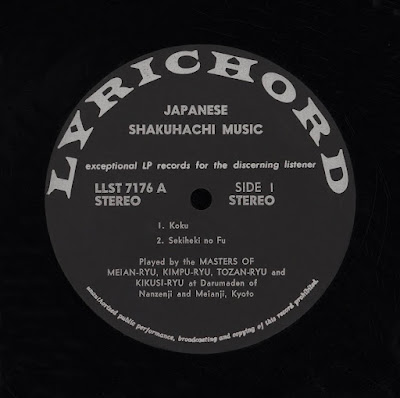JAPAN – JAPON
The bamboo end-blown shakuhachi flute is closely associated with Japanese Zen Buddhism. In the 17th century, monks of the Fuke-shū sect–known as komusō, literally meaning "monks of emptiness" or "priests of nothingness"–adopted the shakuhachi and played a repertoire of pieces called honkyoku as a tool for meditation and spiritual practice.
Though the Fuke sect was abolished in 1871 during the Meiji era, the spiritual tradition of the shakuhachi persisted, often in secrecy. While the shakuhachi is now used in various genres, including classical, folk and jazz, its deep connection to Zen Buddhism and suizen (“blowing Zen” meditation), remains a significant aspect of its cultural and spiritual identity.
This 1967 LP, recorded at the Darumaden of Nanzenji and Melanji Zen temples in Kyoto and released on the essential Lyrichord label, features solos and duets of shakuhachi flutes, of different sizes and pitches, accompanied by chanting, bells and gongs.
This haunting music treats each note as a resonant, meditative breath. It is composed of a wide range of textures and timbres, from soft, low tones to high-pitched, piercing shrills.
La flûte shakuhachi en bambou est étroitement associée au bouddhisme zen japonais. Au XVIIe siècle, les moines de la secte Fuke-shū, connus sous le nom de komusō (littéralement « moines du vide » ou « prêtres du néant »), ont adopté le shakuhachi pour jouer des pièces appelées honkyoku utilisées comme outil de méditation et de pratique spirituelle.
Bien que l'ordre Fuke fut interdit en 1871 pendant l'ère Meiji, la tradition spirituelle du shakuhachi a persisté, souvent dans la clandestinité. Si le shakuhachi est aujourd'hui utilisé dans différents genres musicaux, notamment la musique classique, folklorique et le jazz, son lien profond avec le bouddhisme zen et la méditation suizen (ou « souffle zen ») reste un aspect important de son identité culturelle et spirituelle.
Ce disque de 1967, enregistré au Darumaden, des temples zen Nanzenji et Melanji à Kyoto, et publié sur le label incontournable Lyrichord, présente des solos et des duos de flûtes shakuhachi de tailles et de hauteurs différentes, accompagnés de chants, de cloches et de gongs.
Cette musique envoûtante traite chaque note comme une respiration résonnante et méditative. Elle est composée d'un large éventail de textures et de timbres, allant de tons doux et graves aux sonorités aiguës et perçantes.
A1 – Koku
Composed by Kyochiku (12th century)
Two shakuhachi flutes and gong – Masters of Meian, Kimpu, Tozan and Kikusui Ryus at Meianji, Kyoto.
A2 – Sekiheki No Fu (name of the Chinese poem The Feeling of the Red Wall)
Composed by Seizan Shibata
Vocals, bells, shakuhachi flute (three sizes) – Masters of Meian, Kimpu, Tozan and Kikusui Ryus.
B1 – Matsukaze (the wind through pine trees)
Composed by a member of the Tsugaru family c. 300 years ago
Unknown performer
B2 – Ajikan ("seeing the original sound," a vision associated with enlightenment in Zen meditation
Composed by Nyozan Miyagawa (1868-1946)
B3 – Oshusanya (describes valleys in the Oshu, northern Japan)
Traditional Oshu folk music
3.3 ft (1 meter) long shakuhachi flute – Masters of Meian, Kimpu, Tozan and Kikusui Ryus.
Our other Japanese music posts:
Il Canto Buddhista / Buddhist Chant – Albatros ALB/12 here
Musique Traditionnelle du Japon – Disques Vogue CLVLX 326 here
Gagaku – The Kunaichō Gakubu Ensemble – Toshiba Records TH-9020 here
Gagaku Collection 2 – The Kunaichō Gakubu – Victor SLJ-59 here
Photograph below is from 2000 Years of Japanese Art by Yukio Yashiro and Peter Swann, Thames & Hudson, 1958:
Portrait of Ganjin or Jianzhen (688-763), Nara Period,
made shortly after his death:
Ganjin was a highly revered Tang Chinese monk who helped propagate Vinaya Buddhism in Japan. During his remarkable and arduous efforts to reach Japan, which took him six attempts spanning over a decade from 743 to 754, he lost his eyesight in a storm and shipwreck. “The sensitive modeling of this figure reveals a man calm of soul, resigned to misfortune and at the same time tireless in his missionary zeal.”

Daikokuji-Sasayama Komusō Shakuhachi Daikoku-ji Temple (Sasayama City) Tanba Tea Festival, June 2011 (Wikimedia Commons):
Please help me purchase important traditional records to
pursue my global curation project and share the
best finds with you on this blog here below:





